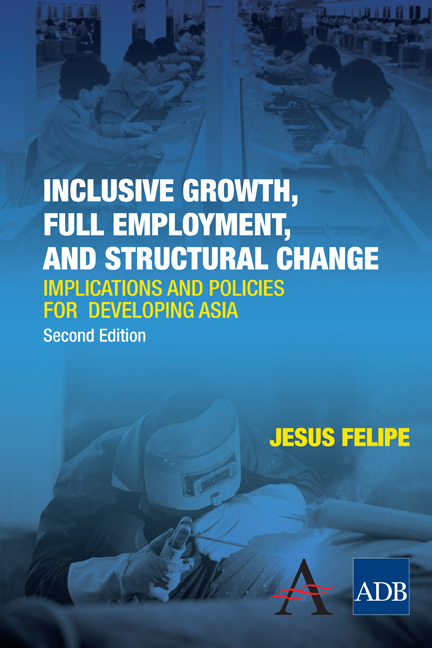 Inclusive Growth, Full Employment, and Structural Change
Inclusive Growth, Full Employment, and Structural Change Book contents
- Frontmatter
- Dedication
- Contents
- Illustrations
- Abbreviations
- Foreword
- Preface and Acknowledgments
- Executive Summary
- Chapter 1 What Is Inclusive Growth?
- Chapter 2 What Is the Main Constraint that Developing Countries Face?
- Chapter 3 Why Full Employment and Who Should Be Responsible for Trying to Achieve It?
- Chapter 4 Why Is Growth Unstable?
- Chapter 5 What Is the Role of Agriculture in the Process of Structural Change and in Delivering Full Employment? Full Employment I
- Chapter 6 What Is the Role of Investment in Delivering Full Employment? Full Employment II
- Chapter 7 Why Is “Planning Development” Necessary?
- Chapter 8 What Is Industrial Policy? Full Employment III
- Chapter 9 Structural Transformation, Industrialization, and Technological Change in Developing Asia: What Does the Empirical Evidence Show?
- Chapter 10 Why Do Export Diversification and Sophistication Matter?
- Chapter 11 Unemployment Versus Inflation: Which One Should Be the Public Enemy Number One?
- Chapter 12 What Should Be the Role of Fiscal and Monetary Policies for Development? Full Employment IV
- Chapter 13 Is It Possible to Achieve Full Employment in the Presence of Structural Transformation?
- Chapter 14 Should the Government (Public Sector) Intervene Directly and Become the Employer of Last Resort? Full Employment V
- Chapter 15 Can Competitiveness and Globalization Deliver Inclusiveness and Full Employment?
- Chapter 16 Export-Led Growth or Domestic Demand–Led Growth?
- Chapter 17 Is Education a Key Ingredient of Inclusive Growth?
- Chapter 18 Conclusions: How Can Developing Countries Implement an Inclusive-Growth and Full-Employment Strategy?
- References
- Author Index
- Subject Index
Chapter 9 - Structural Transformation, Industrialization, and Technological Change in Developing Asia: What Does the Empirical Evidence Show?
Published online by Cambridge University Press: 10 September 2020
- Frontmatter
- Dedication
- Contents
- Illustrations
- Abbreviations
- Foreword
- Preface and Acknowledgments
- Executive Summary
- Chapter 1 What Is Inclusive Growth?
- Chapter 2 What Is the Main Constraint that Developing Countries Face?
- Chapter 3 Why Full Employment and Who Should Be Responsible for Trying to Achieve It?
- Chapter 4 Why Is Growth Unstable?
- Chapter 5 What Is the Role of Agriculture in the Process of Structural Change and in Delivering Full Employment? Full Employment I
- Chapter 6 What Is the Role of Investment in Delivering Full Employment? Full Employment II
- Chapter 7 Why Is “Planning Development” Necessary?
- Chapter 8 What Is Industrial Policy? Full Employment III
- Chapter 9 Structural Transformation, Industrialization, and Technological Change in Developing Asia: What Does the Empirical Evidence Show?
- Chapter 10 Why Do Export Diversification and Sophistication Matter?
- Chapter 11 Unemployment Versus Inflation: Which One Should Be the Public Enemy Number One?
- Chapter 12 What Should Be the Role of Fiscal and Monetary Policies for Development? Full Employment IV
- Chapter 13 Is It Possible to Achieve Full Employment in the Presence of Structural Transformation?
- Chapter 14 Should the Government (Public Sector) Intervene Directly and Become the Employer of Last Resort? Full Employment V
- Chapter 15 Can Competitiveness and Globalization Deliver Inclusiveness and Full Employment?
- Chapter 16 Export-Led Growth or Domestic Demand–Led Growth?
- Chapter 17 Is Education a Key Ingredient of Inclusive Growth?
- Chapter 18 Conclusions: How Can Developing Countries Implement an Inclusive-Growth and Full-Employment Strategy?
- References
- Author Index
- Subject Index
Summary
Progress is impossible without change, and those who cannot change their minds cannot change anything.
—George Bernard ShawI argued in chapter 6 that a key policy to achieve full employment is to spend on investment to increase the investment-to-output ratio. This has been the basis for the policy of industrialization followed by a number of successful East and Southeast Asian economies, including the People's Republic of China (PRC). The result is that the expansion of the manufacturing sector has been the catalytic force underlying the economic transformation that East and Southeast Asia has undergone during the last three decades. As the Asian Development Bank (ADB 2007b), Felipe and Estrada (2008), and Felipe et al. (2007) document, the newly industrialized economies (NIEs), Malaysia, Thailand, Indonesia, and the PRC, have seen their economies transform in the direction of industrialization. And the structures of output and exports have changed in the direction of a higher sophistication, e.g., larger shares of electrical machinery and transport equipment. In this chapter, I provide an in-depth empirical analysis of the transformation of developing Asia's manufacturing sector. Box 9.1 presents the empirical regularities that recent research on the patterns of economic growth has highlighted. These regularities highlight the importance of the manufacturing sector. This has been well known since the work of the British economist Nicholas Kaldor in the 1960s labeled “Kaldor's Laws” (Box 9.2).
Figure 9.1 shows the scatter plot of the annual growth rate of output vis-à-vis the absolute change in the share of manufacturing in total output for the 1970s through 2000–2004. The figure documents the positive correlation between both variables. Among the countries in the first quadrant with the highest increases in the manufacturing share and in the output growth rate are Cambodia, Indonesia, the Republic of Korea, Lao People’s Democratic Republic (Lao PDR), Malaysia, and Thailand. ADB (2007b) provides evidence that growth accelerations are associated with increases in the manufacturing sector.
- Type
- Chapter
- Information
- Inclusive Growth, Full Employment, and Structural ChangeImplications and Policies for Developing Asia, pp. 83 - 156Publisher: Anthem PressPrint publication year: 2010


